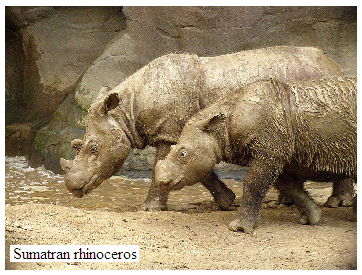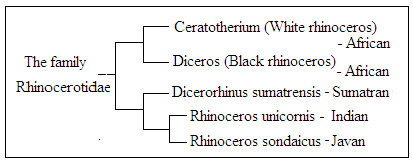Saving the Sumatran rhinoceros from extinction is putting conservation efforts to the test, says S.Ananthanarayanan.
A last ditch push to raise sub-critical numbers of another vanishing instance of our natural heritage may call for different agencies – forestry, veterinary science, policing of poachers, political will and public support, to work together. A communication from the Centre for Macroecology, Evolution and Climate, University of Copenhagen, highlights a paper in Oryx, the journal of conservation efforts worldwide, which raises the question of whether the endangered pachyderm can be saved at all.
A multinational team, Rasmus Gren Havmøller, Junaidi Payne, Widodo Ramono, Susie Ellis, K.Yoganand, Barney Long, Eric Dinerstein, A Christy Williams, Rudy H Putra, Jamal Gawi, Bhibha Kumar Talukdar and Neil Burgess, from Denmark, Malaysia, Indonesia, USA, Switzerland, UK and Assam, in India report in Oryx that Dicerorhinus Sumatrensis, the Sumatran rhino, is on the verge of extinction despite decades of efforts.

The Sumatran rhino is one of five related species, two native to Africa and three to Southern Asia. While the two African and the Indian and Javan rhinoceros emerged as species fourteen to ten million years ago, the Sumatran rhino is the remnant of a group which emerged twenty million years ago. In contrast, the elephant dates about 6 million years ago and Homo sapiens, or modern man, dates only from to 1.8 0.2 million years ago. The Sumatran rhino hence represents the oldest of the mega fauna of prehistory. Now that we have tools to follow genetic trails of the evolution of species, allowing a species of such antiquity to slip into extinction would amount to losing the earliest milestones along the march of vertebrates.

The differentiating characteristic of the rhinoceros is its horn, the African and Sumatran species have two of them and the Indian (Unicornis) and Javan have one. The horn is made of keratin or the material of hair and nails and is the chief defense of the rhinoceros, to be used when provoked, as the animal is a vegetarian, living on leaves and grass. But the rhino horn is prized, both for ornamental use and, what is more pervasive, because folklore has it that the rhino horn has medicinal properties, and this has proved a greater threat to the survival of the rhino than any natural predator. The rhino has hence been hunted and poached and while there has been loss of foraging territory due to human settlement, being hunted for its horn has been the greater reason for the species’ decline in numbers.
All sub-species of the rhinoceros are threatened, but the Javan and Sumatran rhinos are in the greatest danger. The Asian rhinos once ranged across Pakistan, India, Nepal, Burma, Malaysia, Sumatra, possibly even China. As rhinos do not live in herds, encroachment of grazing territory can lead to reproductive isolation and decline in numbers. But the real decimator was relentless hunting, to harvest the rhino’s horn. So called medicinal value is ingrained in traditional Chinese medicine, to treat conditions like fever, convulsions, rheumatism or gout, and there is then some belief that the horn can cure snakebites, hallucinations, “devil possession”, and is useful in cancer or for ‘detoxification’. Even for the use of the powered rhino horn for ordinary ailments, however, there is no medical evidence of effectiveness. China is a signatory to the Convention on International Trade in Endangered Species of Wild Fauna and Flora (CITES) and authoritative bodies have moved to dispel the notion of rhino horn having any medicinal value. But such is the power of belief that all of science and social organisations working to save an invaluable part of the earth’s biodiversity are beating their head against a wall. Vietnam is the greatest market for rhino horn, and growing with the prosperity that has come in recent decades. An article in the Economist said that “parts from some endangered species are worth more than gold or cocaine.”
Rescue plan
In the paper in Oryx, the authors review the population status of the Sumatran rhino, the threats that it faces and the status of the emergency plan that was developed by meeting of conservation organisations in April 2013 in Singapore and adopted at Bandar Lampung, Indonesia the same October. While head count of the rhino is always challenging, the current estimates, based on camera traps and partial footprint surveys, show that rhinos have disappeared from most places, except for small pockets, almost all in Indonesia. The Way Khambas National Park was estimated to have 35 rhinos in 2012, which is a strong recovery from the low of 7-16 in 1996. But the whole of Peninsular Malaysia has been found to display no sign of any survivors. Numbers of 21 and 17 rhinos have been confirmed in the Bukit Barisan Selatan National Park and the Leuser Ecosystem, and all together, the count is placed at around a hundred.

This low number is itself a threat to survival of the species, for, as the paper says, the remaining individuals are isolated, which makes breeding events rare. Attempts to breed rhinos in captivity have not been successful, both for the reason that rhinos, being solitary animals, do not live well together when the female is not ready to breed, as well as for the reason that many of the females in the trials had cysts and tumours in their organs of reproduction, a condition that arises from infrequency of pregnancies. The authors of the paper believe that reproductive health would be an area to monitor for the effectiveness of breeding efforts. In a separate communication, Rasmus Gren Havmøller, of the Natural History Museum of Denmark, Centre for Macroecology, Evolution and Climate, Copenhagen, clarifies that the Sumatran rhino has a gestation period of 15-16 months, which suggests that a female rhino would breed every 3-4 years. But this may an ideal and there is little information of what the reproduction rate actually is, says Havmøller.

A key recommendation of the 2013 summit was hence that all rhino populations, even in different countries, be managed as a single group, a ‘metapopulation’, combining separate conservation efforts in a “unifying global strategy”. This was the approach that has proved successful in saving the Indian rhinoceros in Nepal and Assam, in India. “A very effective management strategy that includes strict protection and moving individuals between populations, and re-populating populations in suitable habitats,” employed with the Indian rhino was able increase a depleted host of “probably no more than 200 individuals in total in the early 1900s to today’s number of more than 3,300,” says Havmøller. The population in Assam, in India, has grown by 26% in just eight years from 2006, he says, which holds out the hope that proper management could save the Sumatran rhino, too.
But implementing such measures, of creating an Intensive Protection Zone, survey of the current known habitats, habitat management, captive breeding and mobilizing resources would take great administrative ability and political will. Christy Williams, co-author and coordinator of the WWF Asian and Rhino and Elephant Action Strategy, recalls that that Project Tiger, which saved the tiger in India, owes a lot to Mrs. Indira Gandhi, then prime minister. The condition of the Sumatran rhino is more precarious than that of the tiger, whose population was 1,400 in 1973. And apart from physical conservation measures, there is the need for forceful action to contain poaching. “Similar high level intervention by President Joko Widodo of Indonesia could help pull the Sumatran rhinos back from the brink,” Williams says.
Other safeguards
Some other ideas to deal with the unrelenting pace of poaching:
• Synthetic horn: Firms wish to offer chemically identical substitutes, even material created in the same way as the real horn. But will substitutes be accepted, to replace something that has no real scientific basis and whose use is anchored in ‘belief’?
• Legalise trade: Allowing free trade or flooding the market with rhino horn stocks that are held by the state, may drop the prices and disincentivise killing. But there are questions of how long will this last, and will it not perpetuate a market that we wish to wipe out?
• Dehorning: Surgically removing the horn should render the rhino safe. This has worked in some places, but in others, poachers still kill for the stub of the horn. Dehorning also has its risks and is expensive.
• Poison: injecting poison, not to kill, but render the consumer ill, and a dye to advertise it. In fact, poachers do not care for the consumer. And, then when they do, they turn to unpoisoned rhinos. The poison also depletes and it is impractical to keep rhino horns poisoned and dyed all the time
------------------------------------------------------------------------------------------